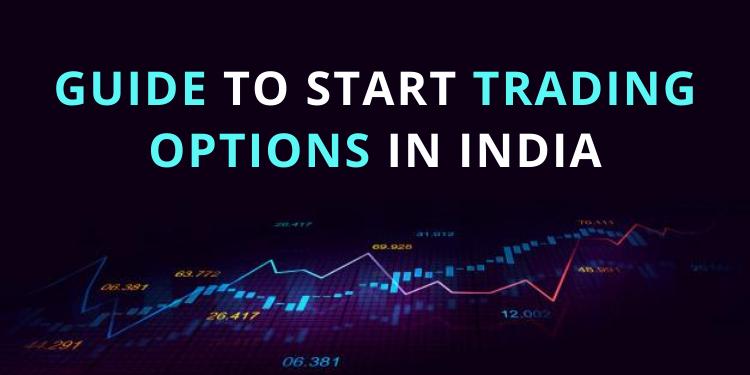

Options trading are a type of contract that allows you to either sell or buy the stock at a predetermined price but you are not obligated to sell or buy the stock. Due to the pandemic situation, a lot of new and existing users have shown interest in Options Trading. But as this topic is not taught in academic institutions, the beginners find it difficult to understand and use it for their benefit. Therefore, we have come up with a step-by-step guide on how to trade options in India.
Options Trading in India – An Overview
Financial leverage acts as one of the biggest benefits of options trading in India. It works by making your investments work harder for you to maximize benefit. In other words, Leverage is a concept of creating scope for bigger profits using a small amount of capital.
Let us take a simple example to understand this concept in detail:
Neeraj is planning to buy a plot of Rs 30 Lakh in the outskirts of his city. He finds out that there is a possibility of a mall coming up in the same area in the next 6 months. He believes that the price of the plot will rise to Rs 40 lakh. But if the mall doesn’t get constructed then the price of the plot may come down to Rs 25 lakh.
Neeraj wants to buy the plot but doesn’t want to pay more. So the owner of the plot gives an option to Neeraj to buy the plot at Rs 30 lakh but he will have to pay a token amount of Rs 1 Lakh for 6 months. Neeraj gets the right to buy or not buy the plot within 6 months and the plot owner is bound by the contract to sell it only to Neeraj.
If the mall comes up and the price of the plot rises to Rs 40 lakhs, then Neeraj is benefited by exercising the right. On the other hand, if the price of the plot falls to Rs 25 lakh, then Neeraj will not exercise the right. In this case, Neeraj won’t go ahead with the deal and will lose the token amount given to the plot owner.
Must Read- How to Invest in Share Market?
Now, if we relate this example to options trading, then Neeraj is the Option Buyer, the plot owner is the Option Seller, the plot is the underlying asset, and the contract price at which Neeraj is ready to buy the plot is called the ‘Strike Price’. The token amount or the upfront money given by Neeraj is called the Premium. The strike price in this example is Rs 30 lakh and the premium is Rs 1 Lakh.
It is possible to buy underlying instruments like commodities, stock, forex, or index for options trading in India.
What are the types of Options Trading in India?
- Options Day Trading – Day trading of options includes selling/ buying of a particular option contract, which is the same as the day trading of stocks. The trader needs to have a view of the stock and trade as per the price action.
- Options Position Trading – Positional trading in options include selling or buying multiple options to form a strategy so that you have positive cash flows until the options are held. In this type of trading, multiple options are used to restrict the loss.
How to do Option Trading In India – Step by Step Guide
Step 1 – To start options trading in India, you need to have an account with the brokers like Zerodha, Upstox, 5Paisa, etc. If you don’t have an account, create one to get started. The steps for options trading are similar in all the trading platforms.
Step 2 – To trade options, you need to have a margin in your trading account. The margin requirement will vary depending on the position taken by you ( investor). If you are an Option Buyer, you need margin to pay for the premium and if you are an option seller, you need to keep some money with the broker to account for M2M ( Market to Market or M2M is a daily cash settlement process for options and futures contract).
Step 3 – Next comes your view on the underlying asset. If you have a bullish view, then you can buy a call option or sell a put option. If you have a bearish view, then you can sell the call option or buy a put option. Buying a call option gives you the right to buy the underlying asset on or before expiry. On the other hand, buying a put option gives you the right to sell the underlying asset on or before expiry.
Step 4: Select the underlying asset you chose to trade and also select the various strike prices that we choose to trade upon. Let’s say you want to trade the Nifty 50 Contract through options and you have a bullish stance on the market. Therefore, you can trade ‘In the Money Call Option ( Nifty 11450 CE), Out of Money Call Option, and At the Money Option ( Nifty 11450 CE).
‘In the Money Option’ is a type of option that would make you money if you were to exercise it right now at the present spot levels.
An ‘At the Money Option’ is the one that is the closest strike price to the current spot levels.
‘Out of Money Option’ is the one that would be worthless if you had to expire it right now.
It is advised to not go too out of money when you are buying an option as there is less chance of them expiring in the money by expiry, and mostly, they expire worthlessly.
Step 5 – Let us assume that you decide to go with ‘At the Money Option’. The next step is to place an order to buy the option. You can choose the option at the current price or place an order place a limit order for a specific price. So, you will have 2 options to buy the contract – Limit or Market.
If you choose the market order, the order will be carried out at the current market price. On the other hand, if you choose the limit order, you have the choice to pick the price at which you want to buy the contract. The total number of shares in a single contract of Nifty is 75. If the option premium is Rs X, then the total premium needed to buy the contract will be 7*X (75 multiplied by X).
Step 6 – Next, check the order book to confirm if the order has been placed. This can be done by clicking on the orders tab.
Step 7 – The last step is to monitor the existing position in the market. You are advised to put a stop loss for every trade to minimize the risk in trading.
Summing Up
- Options are derivative products and they derive their value from the underlying asset.
- A Put option gives you the right to sell the underlying asset upon expiry, whereas the call option gives you the right to buy an underlying asset upon expiry.
- Bearish views can be expressed by either buying a put option or selling a call option.
- Bullish views can be expressed by either buying a call option or selling a put option.
We have given the example of Upstox in this blog as it is a user-friendly platform. But you can do options trading using any other trading platform as the basic steps will remain the same. Happy Trading!














